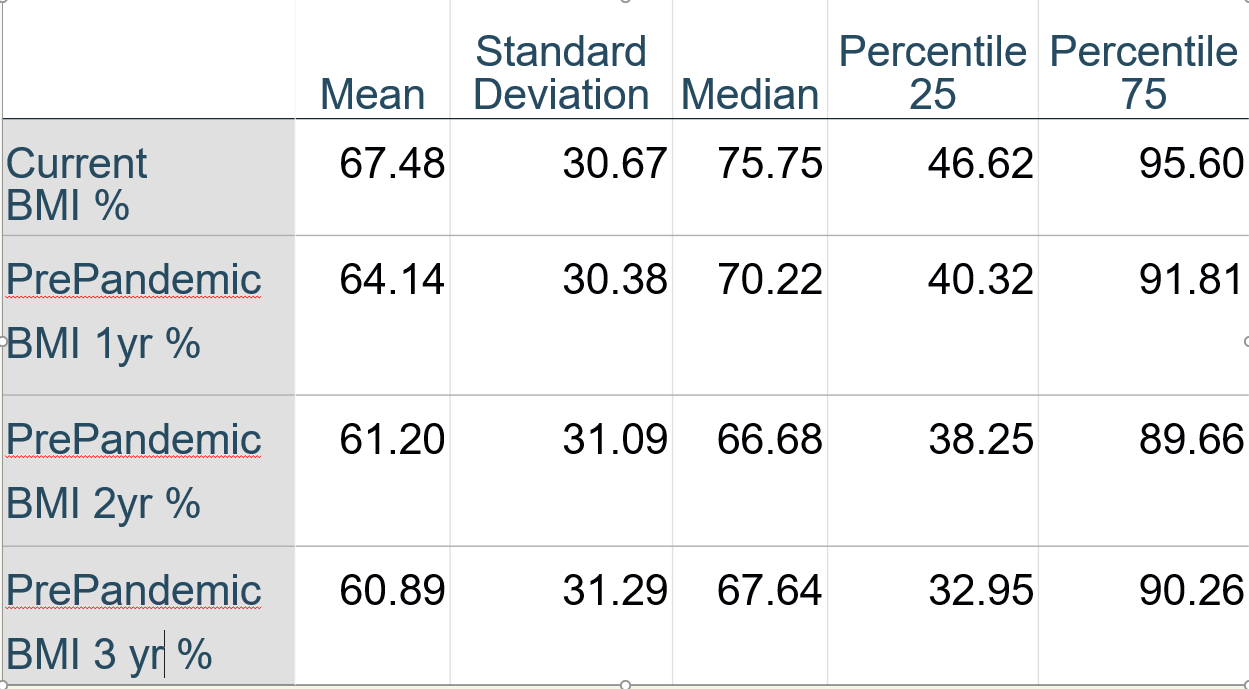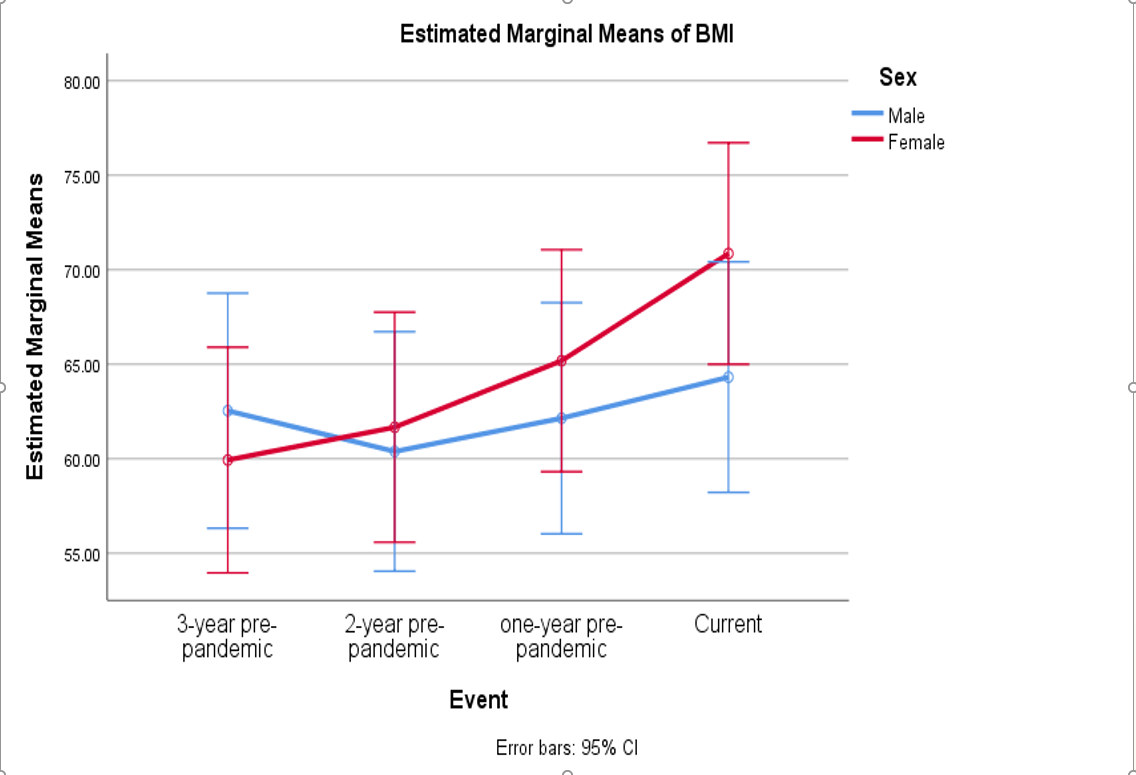Obesity
Category: Abstract Submission
Obesity II
521 - COVID-19 and its effect on BMI year over year in both normal BMI patients and already identified at risk population with BMIs >85% pre-pandemic
Saturday, April 23, 2022
3:30 PM - 6:00 PM US MT
Poster Number: 521
John W. Harrington, Children's Hospital of The King's Daughters, Norfolk, VA, United States; Rylie N. Mainville, Eastern Virginia Medical School, Norfolk, VA, United States; Parth S. Contractor, Eastern Virginia Medical School, Norfolk, VA, United States; Dustin Runzo, Eastern Virginia Medical School, Norfolk, VA, United States; Tamir Abbasi, Children's Hospital of The King's Daughters, Virginia Beach, VA, United States

John W. Harrington, MD (he/him/his)
Vice-President of Quality/Safety and Clinical Integration
CHKD
Norfolk, Virginia, United States
Presenting Author(s)
Background: Although the prevalence of childhood obesity was stabilizing nationally prior to the pandemic, a recent population based study in Pennsylvania showed the rate increasing again in 2021. There is an incomplete understanding of the potential causes for how the pandemic has affected the rate of increase of children’s Body Mass Index (BMI)
Objective: To assess BMI year over year and lifestyle changes during the pandemic versus the previous years prior to the pandemic.
Design/Methods: Patients between the ages of 4 and 17, seen for >2 years and having a recorded BMI for at least 2 visits separated by one year, were enrolled at General Academic Pediatric (GAP) at Children’s Hospital of The King’s Daughters (CHKD) during their well check. Consented patients over age 8 and parents/guardians were also administered a questionnaire that asked about relative changes over the past year in fast food intake, fruit and vegetable intake, water intake, activity level, screen time, and family time. Generalized Estimating Equation (GEE) model was used to analyze the changes in BMI over year and Spearman correlation between BMI and parent’s survey were performed.
Results: Data was collected from 238 pediatric patients; 51% female (122/238). Mean age for males and females was 9.57 and 9.47 years of age respectively. Primary racial demographics were 78% Black, 8% Mixed Race, 7% White, and 3% Hispanic/Latino. Age ranges were in 4 year intervals with 42% of subjects being between 4 and 8 years old; 39% between 9 and 13; and 20% between 14 and 17. BMI percentile did increase over time (p < 0.001), however, when separated by sex, the increase is more significant for females (Fig 1and 2). The increase in BMI percentile over the pandemic correlated positively with an increase in family time (R = 0.164, p = 0.010) and an increase in screen time (R = 0.160, p = 0.012) over the last year(Table 1). No significant correlations were found between the increase in BMI and the four other lifestyle factors investigated.Conclusion(s): These results of a predominantly African-American sample correlate well with the previous population-based study that children’s BMI has increased during the pandemic and more so in females. Two significant factors in this increase were additional time with family and screen usage. Since BMI increase is multifactorial, future studies could focus on investigating other factors that likely may have been affected by the pandemic.
Figure 1 BMI increase during pandemic
BMI increase during pandemic
Figure 2 BMI Increase by sex prior to pandemic and 1 year after in cohort
BMI Increase by sex prior to pandemic and 1 year after in cohort
Objective: To assess BMI year over year and lifestyle changes during the pandemic versus the previous years prior to the pandemic.
Design/Methods: Patients between the ages of 4 and 17, seen for >2 years and having a recorded BMI for at least 2 visits separated by one year, were enrolled at General Academic Pediatric (GAP) at Children’s Hospital of The King’s Daughters (CHKD) during their well check. Consented patients over age 8 and parents/guardians were also administered a questionnaire that asked about relative changes over the past year in fast food intake, fruit and vegetable intake, water intake, activity level, screen time, and family time. Generalized Estimating Equation (GEE) model was used to analyze the changes in BMI over year and Spearman correlation between BMI and parent’s survey were performed.
Results: Data was collected from 238 pediatric patients; 51% female (122/238). Mean age for males and females was 9.57 and 9.47 years of age respectively. Primary racial demographics were 78% Black, 8% Mixed Race, 7% White, and 3% Hispanic/Latino. Age ranges were in 4 year intervals with 42% of subjects being between 4 and 8 years old; 39% between 9 and 13; and 20% between 14 and 17. BMI percentile did increase over time (p < 0.001), however, when separated by sex, the increase is more significant for females (Fig 1and 2). The increase in BMI percentile over the pandemic correlated positively with an increase in family time (R = 0.164, p = 0.010) and an increase in screen time (R = 0.160, p = 0.012) over the last year(Table 1). No significant correlations were found between the increase in BMI and the four other lifestyle factors investigated.Conclusion(s): These results of a predominantly African-American sample correlate well with the previous population-based study that children’s BMI has increased during the pandemic and more so in females. Two significant factors in this increase were additional time with family and screen usage. Since BMI increase is multifactorial, future studies could focus on investigating other factors that likely may have been affected by the pandemic.
Figure 1
 BMI increase during pandemic
BMI increase during pandemicFigure 2
 BMI Increase by sex prior to pandemic and 1 year after in cohort
BMI Increase by sex prior to pandemic and 1 year after in cohort